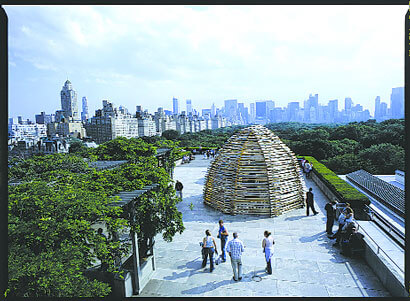The Met’s annual roof garden installation incorporates nature
“Have you been up to the roof garden at the Met? Oh, you should go. So and so and I went just the other night. It’s open late you know. There’s free music. And a bar.”
Warnings closely follow, of hordes of pastel T-shirts of every hue and multi-generational families winding down their day in Gotham, nearly the next best thing to Great Adventure.
Well, the city does welcome tourists from all over. And you survived Ellis Island and the Statue of Liberty, despite feeling like you were in a Fassbinder movie for weeks.
So, yes, brave the jam-packed elevator and the potential neophyte association to see the Andy Goldsworthy installation of white cedar, split-rail domes that house ovoid granite stones stacked in towers.
Goldsworthy, born in Chesire, England, is known for creating work inspired by natural landscapes. In the Cantor Roof Garden’s first site-specific sculptural installation, Goldsworthy has echoed the architecture of the city and the museum, particularly Central Park’s surrounding native trees and limestone, and in so doing contextualizes the misfortune of being right.
Goldsworthy, among other artists including Bill Viola, has brought a Zen-like equanimity to sculpture. In the wake of the brutal constructions of, for example, a Richard Serra, the revolution, though quiet, was inevitable. Now, of course, the revolution is all but won, with the aesthetics not only dominating the Metropolitan’s roof garden but ABC carpets as well. (Michael Phelan, a Goldsworthy successor, targets his sculpture at the “Zenification” of the American Mall.) There is a creepy significance to Goldsworthy’s placement of his stone towers inside his wooden houses, analogous to the confinement of art inside the museum, evocative of the old saying: “Those in glass houses shall throw no stones.”
To Manhattanites, the sense that the city’s vista is international has never been more politically and historically true. We are not exactly Americans, not exactly Europeans. We are the black sheep of the First World, the target of the Third, even while adored by all. And, we’re here—sometimes on our roof garden—ineluctably attuned to the question of whom the next stone will hit.


































